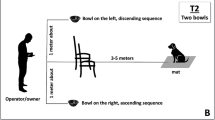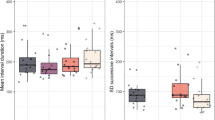Summary
In the present study three groups of cochlear ganglion neurones were detected which differed in respect to their tone-evoked and spontaneous activity: auditory units which showed an irregular spontaneous discharge, non-auditory neurones with regular activity and such with an irregular spontaneous discharge pattern. Electricallyelicited contractions of the middle-ear muscle influenced the tone-evoked and/or the spontaneous activity of the auditory and the non-auditory neurones with irregular spontaneous discharge but not, however, the regularly firing units (Figs. 1–4). Similar results were obtained with imposed perilymph movements in the cochlea (evoked via the vestibular system; Figs. 5, 6). Fractions of all three groups of cochlear ganglion neurones were responsive to direct deformations of the membraneous lagena (Figs. 7, 8). Several (auditory and non-auditory) units with irregular discharge were excited during a basilar membrane displacement towards scala vestibuli whereas a basilar membrane motion towards scala tympani resulted in a decrease of the discharge rate. A few units showed a different reaction. The results provide evidence that the neurones with periodic spontaneous discharge innervate the lagena and that this sense organ has no auditory significance in birds. The peripheral origin of the ‘non-auditory’ neurones with irregular spontaneous activity remains undecided and might be the macula lagenae or the apical portion of the basilar papilla.
Similar content being viewed by others
Abbreviations
- CF :
-
characteristic frequency
- MEM :
-
middle-ear muscle
- SPL :
-
sound pressure level
References
Boord RL (1961) The efferent cochlear bundle in the caiman and pigeon. Exp Neurol 3:225–239
Borg E, Counter SA, Rydquist B (1979) Contraction properties and functional morphology of the avian stapedius muscle. Acta Otolaryngol (Stockh) 88:20–26
Chandler JP (1984) Light and electron microscopic studies of the basilar papilla in the duck,Anas platyrhynchos I. The hatchling. J Comp Neurol 222:506–522
Counter SA, Borg E (1979) Physiological activation of the stapedius muscle inGallus gallus. Acta Otolaryngol (Stockh) 88:13–19
Crawford AC, Fettiplace R (1983) Auditory nerve responses to imposed displacements of the turtle basilar membrane. Hearing Res 12:199–208
Fay RR, Olsho LW (1979) Discharge patterns of lagenar and saccular neurons of the goldfish eighth nerve: Displacement sensitivity and directional characteristics. Comp Biochem Physiol A 62:377–386
Fernandez C, Goldberg JM (1976) Physiology of peripheral neurons innervating otolith organs of the squirrel monkey. I. Response to static tilts and to long-duration centrifugal force. J Neurophysiol 39:970–984
Firbas W, Müller G (1983) The efferent innervation of the avian cochlea. Hearing Res 10:109–116
Golubeva TB (1971) Activity of the tympanic muscle of the long-eared owl under the effect of an auditory tonal signal. Vestn Mosk Univ Ser 6 Biol Pochvoved 26:104–106
Golubeva TB (1972) The reflex activity of the tympanal muscle in the owlAsio otus. Zhurn Evol Biol Fiziol 8:173–181
Gross NB, Anderson DJ (1976) Single unit responses recorded from the first order neuron of the pigeon auditory system. Brain Res 101:209–222
Jørgensen JM (1970) On the structure of the macula lagenae in birds with some notes on the avian macula utriculi and sacculi. Vidensk Medd Dansk Naturh Foren 133:121–147
Khan NS, Müller-Arnecke H, Röskenbleck H, Trincker DEW (1979) Function of different receptor systems in the reptilian labyrinth. Arch Otolaryngol 224:31–35
Kohlloeffel LUE (1984) Notes on the comparative mechanics of hearing II. On cochlear shunts in birds. Hearing Res 13:77–81
Konishi T, Nielsen DW (1978) The temporal relationship between basilar membrane motion and nerve impulse initiation in auditory nerve fibers of guinea pigs. Jpn J Physiol 28:291–307
Kreithen ML, Quine DB (1979) Infrasound detection by the homing pigeon: a behavioral audiogram. J Comp Physiol 129:1–4
Manley GA (1980) Response characteristics of auditory neurons in the cochlear ganglion of the starling. In: Nöhring R (ed) Acta XVII Congr Int Ornithol Berlin 1978. Deutsche Ornithologen-Gesellschaft, Berlin, pp 697–700
Manley GA (1981) A review of the auditory physiology of the reptiles. Progr Sens Physiol 2:49–134
Manley GA, Leppelsack HJ (1977) Preliminary data on activity patterns of cochlear ganglion neurons in the starling. Coll Inst Sante Rech Med 68:127–136
Manley GA, Leppelsack HJ (1978) Die Aktivität der Nervenzellen in der Cochlea von Vögeln. Verh Dtsch Zool Ges 1978:190
Manley GA, Gleich O (1984) Avian primary auditory neurons: the relationship between characteristic frequency and preferred intervals. Naturwissenschaften 71:592–594
Manley GA, Gleich O, Leppelsack HJ, Oeckinghaus H (1985) Activity patterns of cochlear ganglion neurones in the starling. J Comp Physiol A 157:161–181
Møller AR (1974) The acoustic middle ear muscle reflex. In: Keidel WD, Neff WD (eds) Auditory system (Handbook of sensory physiology, vol V/1). Springer, Berlin Heidelberg New York, pp 519–548
Narins PM (1975) Electrophysiological determination of the function of the lagena in terrestrial amphibians. Biol Bull 149:438
Necker R, Schwartzkopff J (1969) Entstehungsort und räumliche Verteilung der Mikrophon- und Summationspotentiale im Vogelohr. Naturwissenschaften 56:92
Oeckinghaus H (1978) Einfluss von Kontraktionen des Mittelohrmuskels auf die Entladungen von Hörnervenelementen beim Star. Verh Dtsch Zool Ges 1978:191
Oeckinghaus H, Schwartzkopff J (1975) Elektrische Aktivierung des Mittelohrmuskels beim Star. Naturwissenschaften 62:582
Oeckinghaus H, Schwartzkopff J (1983) Electrical and acoustical activation of the middle ear muscle in a songbird. J Comp Physiol 150:61–67
Pohlman AG (1921) The position and functional interpretation of the elastic ligaments in the middle-ear region ofGallus. J Morphol 35:229–262
Pumphrey RJ (1961) Sensory organs: Hearing. In: Marshall T (ed) Biology and comparative physiology of birds, vol II. Academic Press, New York London, pp 69–86
Retzius G (1884) Das Gehörorgan der Wirbelthiere. II. Das Gehörorgan der Reptilien, der Vögel und der Säugethiere. Samson und Wallin, Stockholm
Sachs MB, Woolf NK, Sinnot JM (1980) Response properties of avian auditory-nerve fibers and medullary neurons. In: Nöhring R (ed) Acta XVII Congr Int Ornithol Berlin 1978. Deutsche Ornithologen-Gesellschaft, Berlin, pp 710–713
Sachs MB, Young ED, Lewis RH (1974) Discharge patterns of single fibers in the pigeon auditory nerve. Brain Res 70:431–447
Rubel EW (1984) Ontogeny of auditory system function. Annu Rev Physiol 46:213–229
Satoh N (1917) Der histologische Bau der Vogelschnecke und ihre Schädigung durch akustische Reize und durch Detonation. Schwabe, Basel
Schwartzkopff J (1958) Über den Einfluss der Bewegungsrichtung der Basilarmembran auf die Ausbildung der Cochlea-Potentiale vonStrix varia undMelopsittacus undulatus. Z Vergl Physiol 41:35–48
Schwartzkopff J (1968) Structure and function of the ear and of auditory brain areas in birds. In: de Reuck AVS, Knight J (eds) Hearing mechanisms in vertebrates. Churchill, London, pp 41–63
Schwartzkopff J, Brémond JC (1963) Méthode de dérivation des potentiels cochléaires chez l'oiseau. J Physiol (Paris) 55:495–518
Schwartzkopff J, Winter P (1960) Zur Anatomie der Vogelcochlea unter natürlichen Bedingungen. Biol Zentralbl 79:607–625
Stresemann E (1934) Sauropsida, Aves. In: Kükenthal W, Krumbach T (eds) Handbuch der Zoologie, vol VII/2. de Gruyter, Berlin
Takasaka T, Smith CA (1971) The structure and innervation of the pigeon's basilar papilla. J Ultrastruct Res 35:20–65
Tanaka K, Smith CA (1978) Structure of the chicken's inner ear: SEM and TEM study. Am J Anat 153:251–272
Wada Y (1924) Beiträge zur vergleichenden Physiologie des Gehörorgans. Pflügers Arch 202:46–69
Author information
Authors and Affiliations
Rights and permissions
About this article
Cite this article
Oeckinghaus, H. Modulation of activity in starling cochlear ganglion units by middle-ear muscle contractions, perilymph movements and lagena stimuli. J. Comp. Physiol. 157, 643–655 (1985). https://doi.org/10.1007/BF01351358
Accepted:
Issue Date:
DOI: https://doi.org/10.1007/BF01351358




